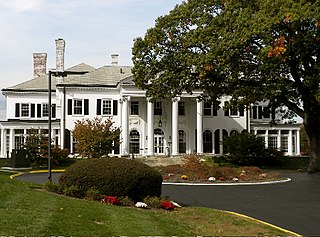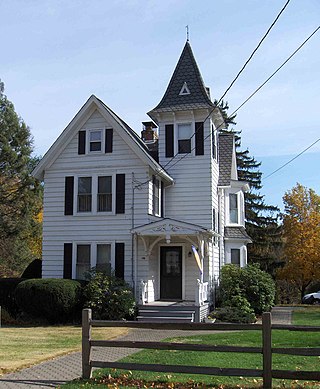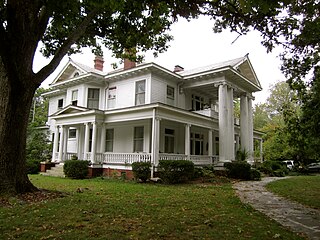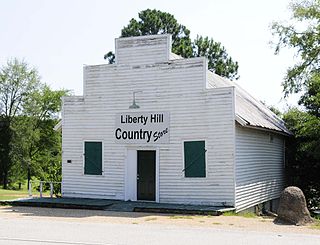
College Hill is a neighborhood in the west central section of the United States city of Greensboro, North Carolina. College Hill was Greensboro's first neighborhood.
The Old Dauphin Way Historic District is a historic district in the city of Mobile, Alabama, United States. It was named for Dauphin Way, now known as Dauphin Street, which bisects the center of the district from east to west. The district is roughly bounded by Broad Street on the east, Springhill Avenue on the north, Government Street on the south, and Houston Avenue on the west. Covering 766 acres (3.10 km2) and containing 1466 contributing buildings, Old Dauphin Way is the largest historic district in Mobile.

The Prospect Hill Historic District is an irregularly-shaped 185-acre (75 ha) historic district in New Haven, Connecticut. The district encompasses most of the residential portion of the Prospect Hill neighborhood.

The Whitney Avenue Historic District is a historic district in the East Rock neighborhood of New Haven, Connecticut. It is a 203-acre (82 ha) district which included 1,084 contributing buildings when it was listed on the National Register of Historic Places in 1989.

Marion is a neighborhood in the town of Southington, Connecticut. It is generally the area in the vicinity of the intersection of Route 322 and Marion Avenue just north of the Cheshire town line.

The Monroe Residential Historic District is a national historic district located at Monroe, Union County, North Carolina. It encompasses 376 contributing buildings, 1 contributing site, and 4 contributing objects in a predominantly residential section of Monroe. The district developed between about 1874 and 1940 and includes notable examples of Italianate, Queen Anne, and Classical Revival architecture styles and includes work by architects Wheeler & Stern and by G. Marion Tucker. Notable buildings include the R. V. Houston House, Houston-Redfearn House, the Belk House, J. H. Lee House, M. G. Sheppard House, Elizabeth Friedeman House, former Methodist Parsonage, Gaston Meares House, William E. Cason House, M. G. Sheppard House, and George B. McClellan House.

The Green Street Historic District is a historic district in Marion, Alabama. It is centered on West Green Street and includes examples of American Craftsman, Greek Revival, and Federal style architecture. It contains 33 structures, dating from the mid-1830s to the present, with 24 of them listed as contributing buildings. It was added to the National Register of Historic Places on May 30, 1979.

Liberty Hill Historic District is a national historic district located at Liberty Hill, Kershaw County, South Carolina. The district encompasses 34 contributing buildings and 2 contributing structures in the small rural community of Liberty Hill. The district includes several imposing Greek Revival structures, Greek Revival cottages, and an 1880s vernacular Gothic Revival church. The later, turn of the 20th century residences are primarily one-story, simple clapboard cottages. The town's history begins as early as ca. 1813 when Peter Garlick's store was a gathering place for surrounding farmers. Soon, impressive structures were built by planters in the area. Remaining from the 1830s are Cool Spring and the Joseph Cunningham House. The majority of the town's antebellum buildings, however, were built ca. 1840–1850. During this period Liberty Hill was a very wealthy community. However, the final days of the American Civil War ended that prosperity. Nevertheless, the town did eventually reassert itself and appears to have changed very little since the beginning of the 20th century.

Winthrop College Historic District is a national historic district located on the campus of Winthrop University at Rock Hill, South Carolina. It encompasses 17 contributing buildings and 1 contributing structure constructed between 1894 and 1943. Architectural styles represented include Gothic Revival, Richardsonian Romanesque, Classical Revival, and Colonial Revival. Notable buildings include the separately listed Tillman Hall and Withers Building, as well as Alumni House, Phelps Dormitory, Thurmond Building, Byrnes Auditorium, Johnson Hall, and the President's Residence.

Reid Street–North Confederate Avenue Area Historic District is a national historic district located at Rock Hill, South Carolina. It encompasses 22 contributing buildings in a middle-class residential section of Rock Hill. The district developed between about 1839 and 1935. Architectural styles represented include Victorian, Classical Revival, Queen Anne, and Bungalow. Notable buildings include the Steed House, Bynum House, Jenkins House, and Gross-Brock House, along with the separately listed White House.

Charlotte Avenue–Aiken Avenue Historic District is a national historic district located at Rock Hill, South Carolina. It encompasses seven contributing dwellings in the Oakland section of Rock Hill. The district developed between about 1891 and 1935. Architectural styles represented include Classical Revival, Queen Anne, and Bungalow. Contributing buildings are the Hughes Walker House, Paul D. Farris House, Roy Z. Thomas House, Wilson House, Armstrong-Mauldin House, and Bays-Blackman House.

South King Street Historic District is a national historic district located at Morganton, Burke County, North Carolina. It encompasses 10 contributing buildings in Morganton. It includes residential, religious, and educational buildings built between about 1893 and 1939. It includes representative examples of Colonial Revival, Georgian Revival, and Gothic Revival style architecture. Notable buildings include the Grace Episcopal Church, Morganton Library, and Works Progress Administration constructed nurses' home.

South Main Street Historic District is a national historic district located at Kernersville, Forsyth County, North Carolina. The district encompasses 53 contributing buildings, 2 contributing sites, and 2 contributing objects in Kernersville. They include residential and commercial buildings built between about 1834 and 1930 in a variety of popular architectural styles including Colonial Revival, Queen Anne, and Bungalow / American Craftsman style. Located in the district is the separately listed Korner's Folly. Other notable buildings include Spears House, Dr. Elias Kerner House (1857), Elias Kerner Huff House (1880), Greenfield and Kerner Tobacco Factory (1884), (former) Bank of Kernersville (1903), DeWitt Harmon's Office, Kernersville Moravian Church (1922), and Main Street United Methodist Church (1924/25).

Belmont Historic District is a national historic district located at Belmont, Gaston County, North Carolina. It encompasses 264 contributing buildings, 1 contributing site, and 2 contributing structures in the central business district and adjacent residential areas of Belmont. The district was developed after 1873, and includes notable examples of Colonial Revival, Tudor Revival, and Bungalow / American Craftsman architecture. Located in the district is the separately listed U.S. Post Office, Former. Other notable buildings include the R.L. Stowe Mills Office Building, Bank of Belmont (1926), Piedmont and Northern Railroad Depot, Belmont Hotel, Abel C. Lineberger House No. 2 designed by Charles Christian Hook (1870–1938), Samuel Pinckney Stowe House, James W. Stowe House, Sacred Heart College, and Belmont High School (1939).

Fisher Park Historic District is a national historic district in the Fisher Park neighborhood, Greensboro, Guilford County, North Carolina. The district encompasses 541 contributing buildings, 2 contributing sites, and 44 contributing structures in a predominantly residential section of Greensboro. The houses were largely built between the 1900s and 1930s and include notable examples of Queen Anne, Colonial Revival, Gothic Revival, American Foursquare, and Bungalow / American Craftsman-style architecture. Located in the district are the separately listed Dixon-Leftwich-Murphy House, John Marion Galloway House, Julian Price House, and Latham-Baker House. Other notable buildings include the First Presbyterian Church (1928), Holy Trinity Episcopal Church (1922), Gant-McAlister House, and A.J. Schlosser House.

Hill–Grainger Historic District, also known as the North Queen Street Area, is a national historic district located at Kinston, Lenoir County, North Carolina, USA. It encompasses 172 contributing buildings in a predominantly residential section of Kinston. The buildings include notable examples of Queen Anne, Colonial Revival, Tudor Revival and Bungalow / American Craftsman style architecture and date between 1900 and 1941. Notable buildings include the (former) Grainger High School, Sarahurst (1902-1904), Vernon Hall (1913-1914), (second) H. C. Hines House (1929), Canady-Sutton House, Hobgood-Sparrow House (1926), (first) H. C. Hines House, and the Fields Rasberry House.

Marshall Main Street Historic District is a national historic district located at Marshall, Madison County, North Carolina. It encompasses 40 contributing buildings in the central business district of Marshall. It includes notable examples of Classical Revival architecture and buildings dating the mid-19th century through 1950. Located in the district are the separately listed Bank of French Broad designed by James J. Baldwin and Madison County Courthouse designed by Smith & Carrier. Other notable buildings include the Rock Café Restaurant (1947), Colonel Lawrence M. Allen House, M. E. Church South (1912), O.C. Rector Building (1928), and Tweed's Department Store.

Chapel Hill Historic District is a national historic district located at Chapel Hill, Orange County, North Carolina. The district encompasses 46 contributing buildings, 2 contributing structures, and 2 contributing objects on the central campus of the University of North Carolina at Chapel Hill and surrounding residential sections of Chapel Hill. The district's buildings date from 1795 to the early-20th century and include notable examples of Classical Revival and Jacobean Revival architecture. Located in the district and separately listed are the Chapel of the Cross, Old East, building and Playmakers Theatre. Other notable contributing resources are the Davie Poplar, Old West (1822), South Building (1798), the Old Well, Person Hall (1797), Gerrard Hall (1822), New East, New West, the Joseph Caldwell Monument (1858), the Y.M.C.A. Building, Battle-Vance-Pettigre11 Dormitory (1913), Horace Williams House (1854), the Phillips Law Office, the Phillips House (1856), the Old Methodist Church (1853), Senlac, Hippol Castle (1920s), and Battle Park.

The Waxhaw–Weddington Roads Historic District is a national historic district located at Monroe, Union County, North Carolina. It encompasses 18 contributing buildings, 2 contributing structures, and 1 contributing object in a predominantly residential section of Monroe. The district developed between about 1897 and 1940 and includes notable examples of Prairie School, Queen Anne, and Classical Revival architecture styles and includes work by architects Charles Christian Hook and by G. Marion Tucker. Notable buildings include the Redwine Tenant House (1907), Robert B. Redwine House (1908), Heath House (1897), Edward Crow House (1916), and Crow's Nest.

Hills and Dales Historic District is a national historic district located at West Lafayette, Tippecanoe County, Indiana. The district encompasses 136 contributing buildings and 39 noncontributing buildings in a predominantly residential section of Lafayette, platted in 1922–1924. It developed between about 1911 and 1951 and includes representative examples of Colonial Revival, Tudor Revival, French Renaissance, and Ranch style architecture. Notable contributing buildings include the Haniford House, Herbert Graves House,, and Marion J. Eaton House.























